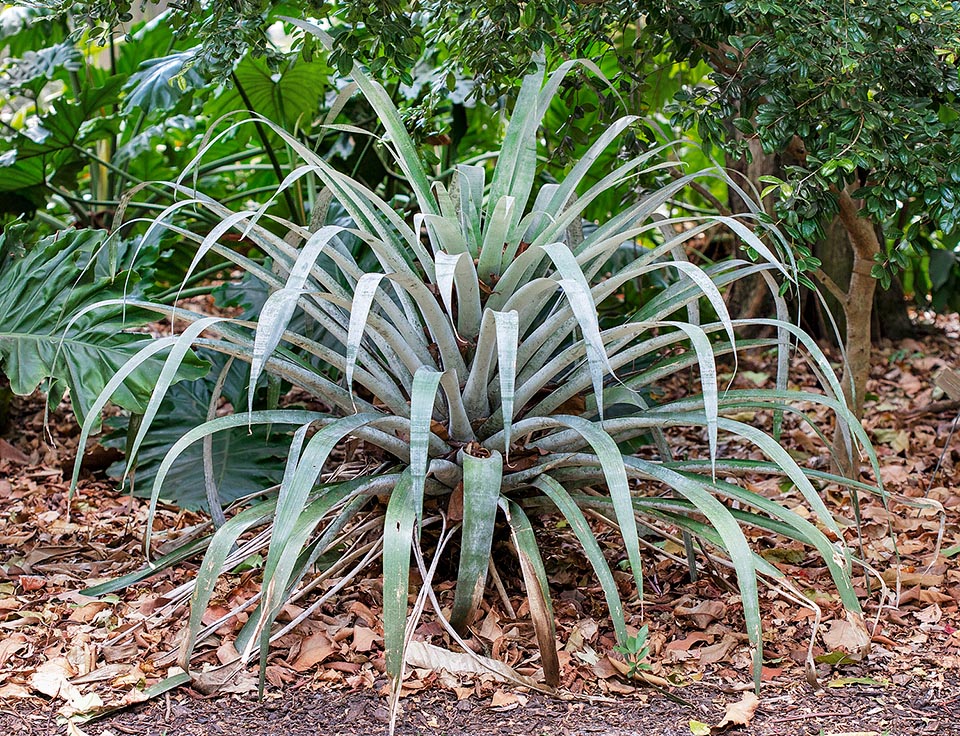Family : Bromeliaceae

Text © Pietro Puccio

English translation by Mario Beltramini
The species is native to Brazil (Minas Gerais and Rio de Janeiro) where it grows in the rainforest (Mata Atlântica) on inselberg (cupuliform reliefs of rocks mainly granitic that rise abruptly on the surrounding level with sparse or absent vegetation) and extremely steep exposed slopes, at low and medium altitudes.
The genus is dedicated to the second and last emperor of Brazil Dom Pedro de Alcantara (1825-1891); the specific name is the Latin adjective “odoratus, a, um” = odorous, fragrant, with reference to the flowers.
Common names: fragrant alcantarea (English).
The Alcantarea odorata (Leme) J.R.Grant (1995) is an evergreen, monocarpic, herbaceous species, rupiculous, 0,8-1,2 m tall and broad, formed by a short and stocky woody stem surmounted by a dense funnel-shaped rosette of leaves and by a robust root system that allows its anchorage on the steep rocky clefs. The central cavity collects rain water and animal and vegetal debris, that decomposing furnish nourishment to the plant, and in the meantime offers shelter and food to numerous small organisms.
Numerous leaves, initially ascending, then more or less curved, linear with slightly acuminate apex and entire margin, of pale green colour and covered by a grey-silvery bloom with bluish reflections thicker in the adult plants, up to about 1 m long and 7-10 cm broad.
Erect inflorescence at the center of the rosette, 1,8-2,2 m long, formed by a robust floral scape entirely covered by bracts similar to the leaves, much longer than the internodes, ending in a compound raceme, that is formed by more racemes departing from a central axis. The bracts under the single racemes are similar to those of the scape, but shorter, of green color tending to reddish. The single racemes, more or less drooping, 16-18 cm long at the base and decreasing towards the apex, bear, arranged alternate on two lines and spaced of 0,8-1,5 cm, numerous fragrant flowers subtended by elliptic green bracts, 2-2,5 cm long and broad.

The Alcantarea odorata is a Brazilian evergreen herbaceous species, about 80 cm tall and 120 cm broad, with solid roots to anchor on the rocky slopes. The numerous linear silvery leaves, before ascending then more or less curved, are arranged in rosette and convey the rain water and debris to a central reservoir. Water and food reserve for the plant, source of life for numerous small organisms. It blooms only once and dies, but in the meantime around the base are born many new young plants © Giuseppe Mazza
Calyx with 3 obovate sepals with rounded apex, corolla with 3 yellow linear petals, retroflexed, about 7 cm long and 0,8 cm broad, 6 white stamens, about 7 cm long, arranged in two series of 3, and style, slightly longer than the petals, of white color. The fruits are fusiform berries containing several thin seeds provided on the two extremities of feathery appendages that favor their dispersion.
After the blooming and the fructification, that lasts several months, the plant stops growing and after a rather long time dries up, but in the meantime has produced at the base new plants, to which transfers nutrients for their initial growth, that in their turn will bloom after 8-10 years depending on the conditions of cultivation. A particular characteristic of the Alcantarea is that of producing new plants at the base, even much time before the blooming, similar to tufts of grass, called in jargon “grass pups”.
It easily reproduces by seed, by micropropagation and through the new plants that produces at the base that may be detached with caution and then rooted.
Species of great proportions and remarkable ornamental value due to the silvery leaves that stand out in the landscape, utilizable as isolated specimen or in group in the gardens of the tropical and subtropical climate regions, its cultivation may be tried in sheltered position in the milder warm temperate zones where temperatures close to 0 °C are rare and short lasting. It requires full sun, for a more intense coloration, but bears also a slight shade, and high temperatures and environmental humidity for an optimal growth. It needs soils rich of organic substance and perfectly draining and aerated, as it does not stand water stagnations, cause of rottenness, maintained almost constantly humid; in the central cavity is to be assured the continuous presence of non-calcareous water. Cultivable also in capacious containers for the decoration of open spaces and, where the climate does not allow this, of greenhouses and luminous winter gardens, with lowest winter night temperatures not under the +15 °C and environmental humidity of 65-80 %. If this is not sufficient recourse can be done to nebulizations to be done in the morning with non-calcareous water at room temperature.
Synonyms:Vriesea odorata Leme (1989).
